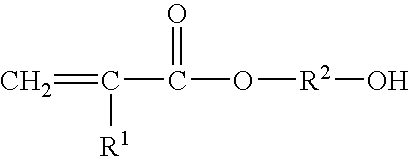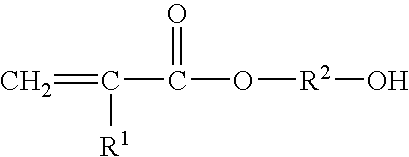Urethane acrylate gel coat resin and method of making
a technology of urethane acrylate and gel coat, which is applied in the direction of coatings, polyurea/polyurethane coatings, etc., can solve the problems of present-day gel coat compositions that fail to meet the requirements of weatherability, color stability, hydrolysis resistance for external applications, automotive applications, etc., and achieve excellent weatherability and color stability.
- Summary
- Abstract
- Description
- Claims
- Application Information
AI Technical Summary
Benefits of technology
Problems solved by technology
Method used
Image
Examples
example 1
[0045] NPG (101.64 wt. parts), MA (60.59 wt. parts), and DBTDL (0.42 wt. parts) were added into a flask equipped with a packed column and agitator. The resulting mixture was heated to a maximum of 440° F. and reacted to an acid number of about 5-10 under a nitrogen atmosphere by removing water (11.14 wt. parts). To the resulting oligoester (151.65 wt. parts) was added 2,6-di-t-butyl-p-cresol (0.65 wt. parts) and HEA (75.71 wt. parts) at 200° F. IPDI (114.28 wt. parts) was added to the resulting mixture via an addition funnel to maintain the exothermic reaction temperature below 200° F. The reaction was maintained at 200° F. for one hour followed by the addition of MMA (107.69 wt. parts) as a solvent and THQ (0.03 wt. parts) as an inhibitor. The resulting product was 80%, by weight, urethane acrylate gel coat resin in 20%, by weight, MMA solvent.
example 2
[0046] The urethane acrylate gel coat resin of this example contains a saturated digester. As in Example 1, the oligoester is reacted with IPDI and HEA to produce a urethane polyester copolymer having acrylic unsaturation at the terminal positions. The resin of Example 2 is prepared in a manner essentially identical to Example 1.
IngredientMolesWt. Parts1. 1,6-Hexanediol2.6924.762. TMP0.07 0.683. Adipic acid2 22.66
[0047] Ingredients 1-3 were reacted under esterifying conditions to remove 5.78 wt. parts of water, and provide an oligoester (40.78 wt. parts) of equivalent weight 239.1. The following ingredients were added to the oligoester, and reacted to form a urethane acrylate gel coat resin of the present invention.
IngredientMolesWt. Parts4. DBTDL0.085. 2,6-di-t-butyl-p-cresol0.136. HEA2.1113.927. IPDI425.308. THQ0.0069. MMA19.79
example 3
[0048] 1,6-Hexanediol (94.8 wt. parts) and TMP (2.6 wt. parts) were added into a flask equipped with an agitator, and the mixture was melted. Next, adipic acid (86.8 wt. parts) was added, and the resulting mixture was heated to 440° F., under a nitrogen atmosphere. An esterification reaction was performed, at a maximum temperature of 460° F., until the acid number was less than 10, preferably less than 7. Water (21.1 wt. parts) was removed during the reaction. The resulting oligoester was cooled to 140° F. using a one part air sparge and 2 part nitrogen blanket. Next, DBTDL (0.31 wt. parts), 2.6-di-t-butyl-p-cresol (0.53 wt. parts), HEA (55.7 wt. parts), and IPDI (101.2 wt. parts) were added to the oligoester. The IPDI was added at a rate such that the exothermic reaction was maintained below 200° F. (e.g., over about 30-60 minutes). The reaction was continued for 2 to 3 hours, periodically testing for free isocyanate groups (% NCO). A % NCO of less than 0.3 is preferred. At the com...
PUM
| Property | Measurement | Unit |
|---|---|---|
| Fraction | aaaaa | aaaaa |
| Fraction | aaaaa | aaaaa |
| Fraction | aaaaa | aaaaa |
Abstract
Description
Claims
Application Information
 Login to View More
Login to View More - R&D
- Intellectual Property
- Life Sciences
- Materials
- Tech Scout
- Unparalleled Data Quality
- Higher Quality Content
- 60% Fewer Hallucinations
Browse by: Latest US Patents, China's latest patents, Technical Efficacy Thesaurus, Application Domain, Technology Topic, Popular Technical Reports.
© 2025 PatSnap. All rights reserved.Legal|Privacy policy|Modern Slavery Act Transparency Statement|Sitemap|About US| Contact US: help@patsnap.com



